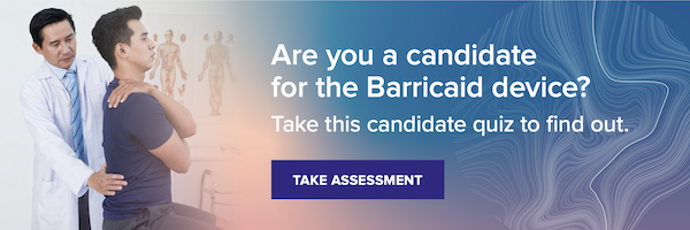
For aging athletes and lifelong workout champions, finding ways to preserve their mobility and continue doing what they love is a must. You know the type: the gray-haired, fit cyclists, swimmers, runners, and rowers we all aspire to be in our senior years.
With that said, the discs in our spines tend to become more fragile over time, making them prone to irritation or injury. Lumbar spine injuries in athletes are all too common and can result from participating in any number of different athletic activities, such as weight lifting and collision sports. This can be problematic for those who are committed to staying active—especially older athletes experiencing natural disc degeneration. However, just because you are a “weekend warrior” doesn’t mean you need to live your life in fear.
Learn more about the aging spine, including how you can protect yours and treat spinal injuries to maintain your athleticism and continue living the active lifestyle you love:
Understanding the Aging Spine
Our lumbar discs are shock absorbers that protect the spine, cushioning the vertebrae and reducing stress caused by impact. As we age, those discs lose water and begin to dehydrate (dessicate), shrink, stiffen, and stop cushioning the vertebrae in the spine. In fact, disc dessication starts as early as 25 years of age in men and 30 years of age in women, and nearly everyone experiences some level of spinal degeneration after age 40.
This can cause our lumbar discs to lose their shock-absorbing capacity, flexibility, and elasticity, all of which can lead to nerve root irritation and spinal cord compression. The process—which is known as disc degeneration or degenerative disc disease—is not actually a disease but rather a term used to describe the progressive changes to our spinal discs throughout the aging process.
Not all cases of degenerative disc disease are painful. Symptoms vary based on an athlete’s lifestyle and severity of disc degeneration. However, some aging athletes—particularly those with spinal injuries or conditions, such as lumbar disc herniation—may experience painful symptoms, such as leg pain, lower back pain, pain that is intermittent, tingling and numbness in the legs (paresthesias), pain radiating down to the buttocks/thighs, difficulty lifting the foot (foot drop), and decreased mobility. The outer layer of the disc (annulus fibrosus) can rupture, forming an annular tear or defect, and the inner layer of the disc (nucleus pulposus) can exit the disc space and directly impinge upon the nearby nerve root. This is often referred to as a disc herniation but may also be labeled a ruptured disc, disc bulge, disc protrusion, disc extrusion, or sequestered disc fragment.
And for aging athletes dodging and recovering from lumbar spine injuries? Losing mobility is simply unfathomable.
Protecting Your Spine as You Age
Although the spinal aging process is natural and to be expected, it’s often incredibly challenging for athletes in their golden years. That said, if you’re determined to stay active as you age, you can minimize the impact of disc degeneration and decrease pressure to your nerve roots and spinal cord by taking certain precautions and knowing which lifestyle risks to avoid. You can protect your spine as you age by adhering to the following practices:
Committing to regular exercise and stretching
A commitment to regular exercise and stretching can help reduce your risk of injury as well as any painful symptoms caused by disc degeneration. Certain exercises (e.g., swimming, cycling, and walking) and stretching programs such as yoga are the optimal approaches for athletes either looking to prevent or recover from a sports-related injury. In general, non-impact aerobic conditioning on our vertebrae that impact loading activities (e.g. running, jumping, squatting with weights).
Using proper heavy lifting techniques
Lifting heavy objects without bending at the knees can put a serious strain on your lumbar spine. In fact, lifting and carrying a bottled beverage case puts more than twice the pressure on the spine compared to jogging and eight times as much as is contained in the average car tire. Bend your knees and avoid twisting your spine to minimize pressure and reduce your risk of injury when lifting heavy objects. In addition, carrying heavier objects closer to the body decreases the lever arm and therefore decreases the stress on the vertebrae and discs.
Maintaining a healthy body weight
Obesity puts excess weight and pressure on our lumbar discs, increasing the risk of lumbar disc herniation as well as any associated symptoms. By maintaining a healthy body mass index (BMI), you can decrease the pressure put on your spine as well as any painful symptoms you’re experiencing in the process. In addition, diabetics must be diligent to maintain a healthy blood glucose level. This can be monitored with Hemoglobin A1C levels with a goal HgA1C less than 6.0.
Staying hydrated and eating nutritious foods
The food and beverages we use to fuel our bodies also impact spine health. Make sure to drink the right amount of water each day and maintain a balanced, nutritious diet on a regular basis to ensure you’re properly hydrated and enjoy anti-inflammatory benefits.
Ensuring proper posture at all times
Maintaining good posture helps keep bones and joints correctly aligned, preventing excess wear and tear that can lead to painful spinal conditions such as herniated discs. Make sure you always practice good posture to protect your spine whether you’re exercising, sitting, standing, or even sleeping.
Quitting use of tobacco products
Cigarette smoking and the use of other tobacco products has a proven negative impact on both spinal health and healing. Smokers are at an increased risk of pain caused by disc degeneration and spinal instability. Smoking cessation can help reduce your risk of injury and improve your body’s ability to heal.
Treating Lumbar Spine Injuries in Athletes
Sometimes, despite our best efforts, lumbar spine injuries are unavoidable—especially when it comes to very athletic individuals engaging in high-impact sports and exercise. Fortunately, there are both nonsurgical and surgical treatments available for injured athletes looking to recover and get back to play.
Like most patients struggling with painful spinal injuries/conditions, aging athletes recovering from an injury typically first explore more conservative, nonsurgical treatments to relieve their symptoms, such as physical therapy, stretching, hot and cold therapies, pain management (such as non-steroidal anti-inflammatory drugs [NSAIDs]), activity modification, and rest. Nonsurgical treatment is effective for more than 90 percent of athletes with a lumbar disc herniation.
In the event that nonsurgical treatments fail, some patients undergo lumbar discectomy surgery to alleviate pain caused by a lumbar herniated disc. Lumbar discectomy (or lumbar microdiscectomy) is a gold standard treatment for athletes looking to maintain their athleticism and active lifestyle, regardless of their age.
For aging athletes with large holes in their disc, discectomy with Barricaid implantation may be the best option for surgically treating a spinal injury while still maintaining mobility and continuing doing what they love. The Barricaid device is designed for patients with a higher risk of a repeat disc herniation, and is proven to reduce the chances of recurring symptoms and the need for another lumbar discectomy surgery.
Only a doctor can determine whether discectomy with Barricaid is the best treatment option for you. Meet with a spine specialist to ask questions, learn the optimal treatment option for you, and determine the best path forward based on your unique situation. You can learn more about if you’re a candidate for Barricaid with this quiz. By taking the right precautions and living a healthy lifestyle, you can protect your spine, get your life back, and stay active as you age—and never look back.
While this blog is meant to provide you with information you need to make an informed decision about your treatment options, it is not intended to replace professional medical care or provide medical advice. If you have any questions about the Barricaid, please call or see your doctor, who is the only one qualified to diagnose and treat your spinal condition. As with any surgical procedure, you should select a doctor who is experienced in performing the specific surgery that you are considering.
If you have any questions about the Barricaid, you may ask your doctor. For additional information, please visit www.barricaid.com. For complete risk-benefit information: www.barricaid.com/instructions.
References
1 “Degenerative Disc Disease,” Cleveland Clinic, 2021, https://my.clevelandclinic.org/health/diseases/16912-degenerative-disc-disease.
2 H.J. Wilke et al, “New in vivo measurements of pressures in the intervertebral disc in daily life,” Spine 24, no. 8 (1999): 755-672, doi: 10.1097/00007632-199904150-00005.
3 Ibid.
4 Susan Spinasanta et al, "Smoking, Tobacco Use, E-Cigarettes And Spine Surgery," Spine Universe, Remedy Health Media, updated July 16, 2019, https://www.spineuniverse.com/treatments/surgery/smoking-tobacco-use-cigarettes-spine-surgery.
5 Akshay Gadia et al, “Outcomes of Various Treatment Modalities for Lumbar Spinal Ailments in Elite Athletes: A Literature Review,” Asian Spine Journal 12, no. 4 (2018): 754-764, doi: 10.31616/asj.2018.12.4.754.



Comments